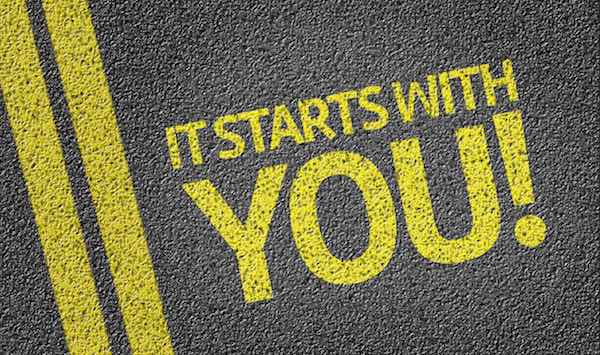Unconscious Behavior
"People Awareness" presents the various observable patterns of innate temperaments and interpersonal styles. Each distinct pattern is a self-reinforcing system within its own ecosystem, which means that one cannot mix and match attributes of one with ones of another. People are consciously aware of some of these attributes in them, while others remain obscured to them unless they invest a significant amount of time into increasing their self-awareness on their own.
"Happy people seem much alike" goes the saying, and yet this seems actually true. It is when people don't get their innate needs and desires met that their dissatisfaction shows up differently. The first reflex is to try harder in ways which are natural to the distinct pattern. A bird feeling like falling out of the sky will flap its wings faster, until the flapping becomes feverish and desperate. This reflex is responsible for one category of unconscious behavior: the one that if we were consciously observing it would make perfect sense to us, according to our own perception. Unfortunately that's not necessarily the case for the people around us.
People with different innate patterns have an entirely different perception. They may feel irritated, annoyed, possibly even threatened by the feverish flapping out of desperation.
"Happy people seem much alike" goes the saying, and yet this seems actually true. It is when people don't get their innate needs and desires met that their dissatisfaction shows up differently. The first reflex is to try harder in ways which are natural to the distinct pattern. A bird feeling like falling out of the sky will flap its wings faster, until the flapping becomes feverish and desperate. This reflex is responsible for one category of unconscious behavior: the one that if we were consciously observing it would make perfect sense to us, according to our own perception. Unfortunately that's not necessarily the case for the people around us.
People with different innate patterns have an entirely different perception. They may feel irritated, annoyed, possibly even threatened by the feverish flapping out of desperation.

Rather than coming to rescue or offer help, their tone seems off and it makes the experience of falling out of the sky even more unbearable when one is told that flapping one's wings is the wrong thing to do, is inappropriate or outright offensive.
One can become aware of one's own defensive reactions and learn to consciously shift behavior in order to receive rather than discourage support.
Visions of Reality & Actual Reality
Our five senses give us Vision, Hearing, Touch/Feeling, Smell and Taste. They don't inform us in detail about what something is or how it works.
From early childhood onward and then through education people have learned how to interpret the information provided by the five senses into more or less complex connections or meanings. When seeing a small burning fire in the corner of a room, what causes people to act and extinguish it is not the visual information of the small fire. It is the learned knowledge that fire will spread and eventually set the entire building on fire. This knowledge is real. It is repeatable, verifiable, can be consistently explained by knowledge of chemistry and physics and its limits are well known. For instance, without oxygen or with entirely wet walls and floors the fire will go out on its own.
In more complex and especially socially influenced situations, the significance and meanings people make of events, or what they predict to happen are rarely based on knowledge but more often on incomplete subjective understanding. Consequences are feared because they did happen a few times in the past, maybe in conjunction with other factors not occurring at present. Behavior is deemed inappropriate because it isn't the norm, although people aren't quite clear about how things have ended up being the norm to begin with, except that there must have been good reasons.
What is necessary for the success of a project? What kind of product evolution do we need to pursue? How can we save money and increase efficiency? These questions all involve human perceptions, which are almost always filled with distortions, deletions and generalizations. No wonder we have disagreement and numerous opinions, people talking behind someone's back, apparently complying when constrained, but secretly undermining a successful outcome.
From early childhood onward and then through education people have learned how to interpret the information provided by the five senses into more or less complex connections or meanings. When seeing a small burning fire in the corner of a room, what causes people to act and extinguish it is not the visual information of the small fire. It is the learned knowledge that fire will spread and eventually set the entire building on fire. This knowledge is real. It is repeatable, verifiable, can be consistently explained by knowledge of chemistry and physics and its limits are well known. For instance, without oxygen or with entirely wet walls and floors the fire will go out on its own.
In more complex and especially socially influenced situations, the significance and meanings people make of events, or what they predict to happen are rarely based on knowledge but more often on incomplete subjective understanding. Consequences are feared because they did happen a few times in the past, maybe in conjunction with other factors not occurring at present. Behavior is deemed inappropriate because it isn't the norm, although people aren't quite clear about how things have ended up being the norm to begin with, except that there must have been good reasons.
What is necessary for the success of a project? What kind of product evolution do we need to pursue? How can we save money and increase efficiency? These questions all involve human perceptions, which are almost always filled with distortions, deletions and generalizations. No wonder we have disagreement and numerous opinions, people talking behind someone's back, apparently complying when constrained, but secretly undermining a successful outcome.

One important conclusion is that reality is not necessarily what one believes it to be. Careful observation, learning and revising one's understanding will eventually lead to making more accurate predictions and hence better choices. All too often, a majority opinion impedes finding out how things actually are.
Another important conclusion is the apparent need for open dialog, bringing multiple perceptions together, confronting them constructively and converging towards the best available understanding of the situation, upon which the ultimate choice is then made and embraced by all involved people, teams and organizations.
Change the System starting with YOU
No one else can take care of you as well as you can. Develop your Self-Awareness, understand yourself.
Learn what makes you tick, and what offends you. See the pattern behind it. The things that form the essence of who you are and which you cannot change. These are what forms your strengths, talents, interests and core-values. Discover better ways to take care of you, at work as well as at home.
Learn to see the things that do not define you, the things you do without realizing, especially when you feel at your worst. Learn to shift these behaviors so that you can actually have other people respond to you in ways which work better for you and have you fill up your emotional energy level.
This is the foundation for any change you would like to see.
Learn what makes you tick, and what offends you. See the pattern behind it. The things that form the essence of who you are and which you cannot change. These are what forms your strengths, talents, interests and core-values. Discover better ways to take care of you, at work as well as at home.
Learn to see the things that do not define you, the things you do without realizing, especially when you feel at your worst. Learn to shift these behaviors so that you can actually have other people respond to you in ways which work better for you and have you fill up your emotional energy level.
This is the foundation for any change you would like to see.

Being YOU & accepting others as THEY are
You and other people at work, or even in your personal life, form a complex system in which there is no initial identifiable cause leading to an undesirable outcome. There is always interdependency. Your unconscious actions cause a reaction from the other person, making your situation even more unbearable. While at the same time you perceive that the other person's prior actions have caused one of your values being stepped upon, which led you to your action offending the other person.
Once you become aware of the complex system at work, you have the means to change the course of events. This is a powerful choice, yet only available to you once you have shifted your perception and become aware of the feedback loop in the system.
The more you become aware of how your current perception prevents you from seeing the real system at work, the more able you will be to develop a perception that constantly evolves and predicts reality more accurately.
As a result, your decision-making abilities will grow, and you will operate from a place of inner strength, aligned with your own talents, pursuing your own areas of interests, creating what matters most to you, and getting along better with other people upon which your undertakings depend so much.
Once you become aware of the complex system at work, you have the means to change the course of events. This is a powerful choice, yet only available to you once you have shifted your perception and become aware of the feedback loop in the system.
The more you become aware of how your current perception prevents you from seeing the real system at work, the more able you will be to develop a perception that constantly evolves and predicts reality more accurately.
As a result, your decision-making abilities will grow, and you will operate from a place of inner strength, aligned with your own talents, pursuing your own areas of interests, creating what matters most to you, and getting along better with other people upon which your undertakings depend so much.

1-on-1 & Group Coaching
Coaching is different from Mentoring, because we don't tell experienced people what to do. Instead we help them make new connections, see new ways, so they can come up with solutions even better than we could imagine. It's the best possible teamwork! People can’t imagine beforehand how they will grow.
Workshops & Retreats
Decision Makers, Leaders and Managers benefit greatly from understanding how People-Awareness, Self-Awareness, Leadership and Communication all play together towards long-term company success. We co-facilitate Retreats around company-specific challenges and goals in addition to our Workshops.
Want to know more? En savoir plus? Mehr erfahren?
Office location: Silicon Valley, California About us
☏ 🇺🇸🇫🇷🇩🇪 +1 (408) 600-1450 (USA)
☏ 🇺🇸🇫🇷🇩🇪 +33 1.77.62.39.31 (France)
✉️ info@CRexecutiveConsulting.com
☏ 🇺🇸🇫🇷🇩🇪 +1 (408) 600-1450 (USA)
☏ 🇺🇸🇫🇷🇩🇪 +33 1.77.62.39.31 (France)
✉️ info@CRexecutiveConsulting.com
